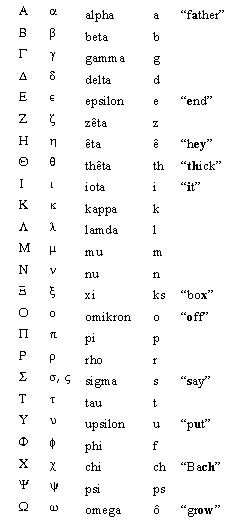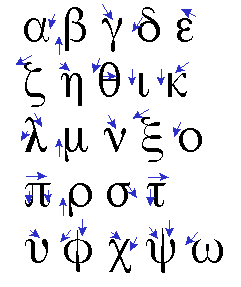Week 1: Alphabet and Accents
15/08/11 13:39
Assignment: Read the Introduction to Hansen and Quinn (pg. 1-10). Due Thursday: Accent Exercise I, and the Pronunciation Exercise on pg. 15. Be sure to write the exercise out, we’ll be reciting some Greek in class.
Welcome to Introductory Ancient Greek!
For the first week we’ll concentrate on mastering the Greek alphabet, pronunciation and accent. Let’s start simple with pronunciation and identification. The best way to master the alphabet is to copy out the letters in order.
The Alphabet


(Credit to ibiblio.org for the charts - you can also check page 2 of the introduction to your text for a similar explanation of each letter).
The Greek letter gamma (γ) can be combined with other consonants in the same way the english letters ’n’ and ‘g’ combine, for example, in skiing. For quick reference:
γγ = ng (anger)
γκ = nk (banker)
γξ = nx (larynx, Sphinx)
γχ = (lunkhead)
You may note that there is no Greek equivalent of the English ‘H/h’ sound. Instead of a separate consonant, Classical Greek employed a rough (‘) and smooth (ʼ ) breathing mark:
ἑξάγωνον “hexagon”
Ἑλένη “Helen”
Greek Accent
In addition to the familiar alphabetic characters, Greek uses the following accent marks: acute (´), grave (`), and circumflex (ˆ). These accents are crucial to spelling and the rules governing them must be memorized.
Unlike English, however, Greek accent was not based on stress, but pitch. the acute accent mark indicated a rising pitch, the grave a lowering pitch, and the circumflex a rising, then lowering pitch. Pitch and tone are used in English as well, to convey emotional or extra-grammatical information, but Greek (like Mandarin Chinese, for example) uses pitch and tone to inflect words and distinguish meanings. Chinese, for example, the syllable “ma” can mean many different things, depending on the tone of delivery:
mā "mom"
mǎ "horse"
Accentuation in Greek can seem daunting, but if you keep a few simple rules in your head, you’ll have no problem remembering which accent goes where. Different parts of speech have different rules for the location of the accent, but the following rules must be observed universally:
1. Only the last three syllables can be accented. These are referred to by Latin terminology: the ultima (the last syllable), the penult (the second the last syllable) and the antepenult (the “one before the second to last syllable” or the third-to-last).
In this chart you can see the rise in pitch, followed by a lowering pitch. The ultima, penult, and antepenult are marked as well:

2. An acute accent can appear on A, P, or U, but on A only when U is short.
3. A circumflex accent cannot appear on a short vowel, nor can it appear on A. It can appear on P only if U is short. An accented long P followed by a short U must have a circumflex. An accented long P followed by a long U must have an acute accent.
4. A grave can only appear on U. It replaced a final acute accent when not immediately followed by punctuation or an enclitic.
So in summation:
The ultima, if short, accented and not followed by punctuation (or enclitic) is acute. If the ultima is long and accented it may be acute or circumflex: in this case the appropriate accent must be memorized.
The penult, if short and accented, must be acute. If long and accented, the penult is acute when followed by a long ultima, circumflex when followed by a short ultima.
The antepenult, is accented only if the ultima is short, and it always bears the acute.
Recessive Accent
Finite verb forms (not the infinitive) have what’s called a recessive accent. This just means that the accent falls as far back from the end of the word as possible. A general rule of thumb is to check the ultima. If it is short, the accent can travel up to the antepenult. If long, it must stop at the penult:
ἔπαυσα - the accent falls on A because the final syllable is short.
επαύσω - the accent falls on P because the final syllable is long.
παῦσον - the accent must be on P (there are only two syllables, and U is short). Because P contains a diphthong and U is short, the accent must circumflex, not acute.
Persistent Accent
Unlike verbs, nouns have persistent accent, that is, the accent does not try to move away from the end of the word, but will attempt to stay on one particular syllable. This must be memorized as part of the spelling.
βιβλίον, βιβλίου. The accent could have gone over A or U, but when we learn the word “book” we’ll memorize the position of the accent over P.
ἄνθρωπος, ἀνθρώπου. The U of ἄνθρωπος contains a short vowel, so the accent is placed on A, but in ἀνθρώπου, the U is long, and thus the accent is forced to P.
We will continue to work with recessive and persistent accents when we learn verb conjugations and noun declensions. For now you should be ready to complete the exercises and drills found on pp. 11-15. For further reference, check out the accentuation tutorial from the University of California at Berkeley (which I used extensively in this post).
Welcome to Introductory Ancient Greek!
For the first week we’ll concentrate on mastering the Greek alphabet, pronunciation and accent. Let’s start simple with pronunciation and identification. The best way to master the alphabet is to copy out the letters in order.
The Alphabet


(Credit to ibiblio.org for the charts - you can also check page 2 of the introduction to your text for a similar explanation of each letter).
The Greek letter gamma (γ) can be combined with other consonants in the same way the english letters ’n’ and ‘g’ combine, for example, in skiing. For quick reference:
γγ = ng (anger)
γκ = nk (banker)
γξ = nx (larynx, Sphinx)
γχ = (lunkhead)
You may note that there is no Greek equivalent of the English ‘H/h’ sound. Instead of a separate consonant, Classical Greek employed a rough (‘) and smooth (ʼ ) breathing mark:
ἑξάγωνον “hexagon”
Ἑλένη “Helen”
Greek Accent
In addition to the familiar alphabetic characters, Greek uses the following accent marks: acute (´), grave (`), and circumflex (ˆ). These accents are crucial to spelling and the rules governing them must be memorized.
Unlike English, however, Greek accent was not based on stress, but pitch. the acute accent mark indicated a rising pitch, the grave a lowering pitch, and the circumflex a rising, then lowering pitch. Pitch and tone are used in English as well, to convey emotional or extra-grammatical information, but Greek (like Mandarin Chinese, for example) uses pitch and tone to inflect words and distinguish meanings. Chinese, for example, the syllable “ma” can mean many different things, depending on the tone of delivery:
mā "mom"
mǎ "horse"
Accentuation in Greek can seem daunting, but if you keep a few simple rules in your head, you’ll have no problem remembering which accent goes where. Different parts of speech have different rules for the location of the accent, but the following rules must be observed universally:
1. Only the last three syllables can be accented. These are referred to by Latin terminology: the ultima (the last syllable), the penult (the second the last syllable) and the antepenult (the “one before the second to last syllable” or the third-to-last).
In this chart you can see the rise in pitch, followed by a lowering pitch. The ultima, penult, and antepenult are marked as well:

2. An acute accent can appear on A, P, or U, but on A only when U is short.
3. A circumflex accent cannot appear on a short vowel, nor can it appear on A. It can appear on P only if U is short. An accented long P followed by a short U must have a circumflex. An accented long P followed by a long U must have an acute accent.
4. A grave can only appear on U. It replaced a final acute accent when not immediately followed by punctuation or an enclitic.
So in summation:
The ultima, if short, accented and not followed by punctuation (or enclitic) is acute. If the ultima is long and accented it may be acute or circumflex: in this case the appropriate accent must be memorized.
The penult, if short and accented, must be acute. If long and accented, the penult is acute when followed by a long ultima, circumflex when followed by a short ultima.
The antepenult, is accented only if the ultima is short, and it always bears the acute.
Recessive Accent
Finite verb forms (not the infinitive) have what’s called a recessive accent. This just means that the accent falls as far back from the end of the word as possible. A general rule of thumb is to check the ultima. If it is short, the accent can travel up to the antepenult. If long, it must stop at the penult:
ἔπαυσα - the accent falls on A because the final syllable is short.
επαύσω - the accent falls on P because the final syllable is long.
παῦσον - the accent must be on P (there are only two syllables, and U is short). Because P contains a diphthong and U is short, the accent must circumflex, not acute.
Persistent Accent
Unlike verbs, nouns have persistent accent, that is, the accent does not try to move away from the end of the word, but will attempt to stay on one particular syllable. This must be memorized as part of the spelling.
βιβλίον, βιβλίου. The accent could have gone over A or U, but when we learn the word “book” we’ll memorize the position of the accent over P.
ἄνθρωπος, ἀνθρώπου. The U of ἄνθρωπος contains a short vowel, so the accent is placed on A, but in ἀνθρώπου, the U is long, and thus the accent is forced to P.
We will continue to work with recessive and persistent accents when we learn verb conjugations and noun declensions. For now you should be ready to complete the exercises and drills found on pp. 11-15. For further reference, check out the accentuation tutorial from the University of California at Berkeley (which I used extensively in this post).